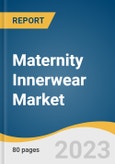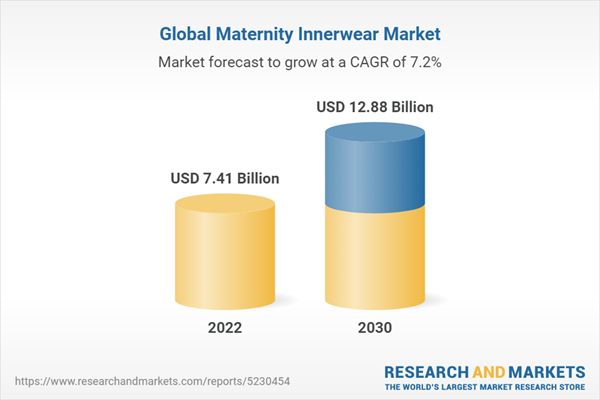The global maternity innerwear market size is expected to reach USD 12.88 billion by 2030. The market is projected to expand at a CAGR of 7.2% from 2023 to 2030. The growth is largely driven by factors such as the increasing participation of women in the global labor force and the growing inclination toward pregnancy fashion.
The opportunity to showcase brands on a larger platform can offer lucrative opportunities to players in the market. Influenced by social media, fashion blogs, magazines, film, and television, consumers today are demanding more from maternity innerwear brands, giving players scope for innovation and experimentation with designs, fabrics, and fit.
Growing fashion consciousness and increasing focus on personal appearance are encouraging expectant mothers to spend more on stylish and trendy maternity innerwear. Apparel brands have been capitalizing on these evolving trends to offer consumers on-trend yet comfortable innerwear while taking into consideration the best fabrics, as well as reconsidering the positioning of elastics, clasps and hooks, and tags that could be uncomfortable at various stages of pregnancy. For instance, Australian author Zoë Foster Blake has been known to wear designer labels like Active Truth and Bras N Things during her pregnancies.
Maternity briefs emerged as the largest segment and accounted for a revenue share of 30.36% in 2021. The segment is expected to continue its dominance during the forecast period. The nursing bras segment is expected to expand at the fastest CAGR of 8.1% from 2022 to 2030. These bras are more comfortable to wear than regular underwear and they are available in various styles to suit the varied requirements of expectant and new moms. Players in the maternity innerwear industry have been offering a range of maternity briefs in online as well as offline stores, which are fueling the demand for the segment.
The maternity innerwear industry is characterized by the presence of various well-established players such as Seraphine; Wacoal; and H & M Hennes & Mauritz AB, and several small- and medium-sized players such as Hatch Collection LLC; MamaCouture; Hotmilk Lingerie; Belabumbum; Fresh Venturz LLP; Clovia; and Triumph Holding AG. The market players face stiff competition as some of them are among the top manufacturers of maternity innerwear and have large customer bases.
The opportunity to showcase brands on a larger platform can offer lucrative opportunities to players in the market. Influenced by social media, fashion blogs, magazines, film, and television, consumers today are demanding more from maternity innerwear brands, giving players scope for innovation and experimentation with designs, fabrics, and fit.
Growing fashion consciousness and increasing focus on personal appearance are encouraging expectant mothers to spend more on stylish and trendy maternity innerwear. Apparel brands have been capitalizing on these evolving trends to offer consumers on-trend yet comfortable innerwear while taking into consideration the best fabrics, as well as reconsidering the positioning of elastics, clasps and hooks, and tags that could be uncomfortable at various stages of pregnancy. For instance, Australian author Zoë Foster Blake has been known to wear designer labels like Active Truth and Bras N Things during her pregnancies.
Maternity briefs emerged as the largest segment and accounted for a revenue share of 30.36% in 2021. The segment is expected to continue its dominance during the forecast period. The nursing bras segment is expected to expand at the fastest CAGR of 8.1% from 2022 to 2030. These bras are more comfortable to wear than regular underwear and they are available in various styles to suit the varied requirements of expectant and new moms. Players in the maternity innerwear industry have been offering a range of maternity briefs in online as well as offline stores, which are fueling the demand for the segment.
The maternity innerwear industry is characterized by the presence of various well-established players such as Seraphine; Wacoal; and H & M Hennes & Mauritz AB, and several small- and medium-sized players such as Hatch Collection LLC; MamaCouture; Hotmilk Lingerie; Belabumbum; Fresh Venturz LLP; Clovia; and Triumph Holding AG. The market players face stiff competition as some of them are among the top manufacturers of maternity innerwear and have large customer bases.
Maternity Innerwear Market Report Highlights
- The increasing number of women participating in the workforce and the growing inclination for pregnancy fashion are the factors foreseen to drive the growth of the market in the forthcoming years
- In 2022, Asia Pacific held the largest revenue share of 41.32%. The need for various types of maternity clothes is supplemented by the increasing spending power of the people, which is a key factor fueling the growth of the regional market
- The shapewear segment held a considerable revenue share in 2022. Shapewear is very popular among millennials and celebrities and has been gaining prominence in the maternity space as well
- The offline distribution segment held the largest revenue share of 69.73% in 2022. This purchasing mode offers a rich shopping experience and makes it easier for the consumers to understand the exact size and quality of the maternity innerwear
Table of Contents
Chapter 1. Methodology and Scope
Chapter 2. Executive Summary
Chapter 3. Maternity Innerwear Products Market Variables, Trends & Scope
Chapter 4. Consumer Behavior Analysis
Chapter 5. Maternity Innerwear Products Market: Type Estimates & Trend Analysis
Chapter 6. Maternity Innerwear Products Market: Distribution Channel Estimates & Trend Analysis
Chapter 7. Maternity Innerwear Products Market: Regional Estimates & Trend Analysis
Chapter 8. Competitive Analysis
List of Tables
List of Figures
Companies Mentioned
- Seraphine
- Wacoal
- H & M Hennes & Mauritz AB
- Hatch Collection LLC
- MamaCouture
- Hotmilk Lingerie
- Belabumbum
- Fresh Venturz LLP
- Clovia
- Triumph Holding AG
Methodology

LOADING...
Table Information
| Report Attribute | Details |
|---|---|
| No. of Pages | 80 |
| Published | July 2023 |
| Forecast Period | 2022 - 2030 |
| Estimated Market Value ( USD | $ 7.41 billion |
| Forecasted Market Value ( USD | $ 12.88 billion |
| Compound Annual Growth Rate | 7.2% |
| Regions Covered | Global |
| No. of Companies Mentioned | 10 |









